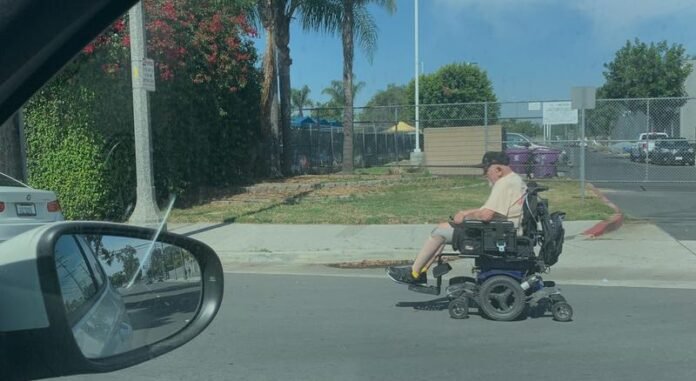Disconnected and disenfranchised, bicyclists and pedestrians in West Long Beach have had to ride or walk on unprotected streets for decades—and it largely continues that way despite proposals to provide the neighborhood with upgraded biking facilities that would increase safety for both pedestrians and bicyclists.
West Long Beach is no exception as this type of lack of safety, particularly along bicycle corridors, has been addressed by urban planners and traffic engineers nationwide through the use of the “8-80 rule.”
It basically goes as such: Would you feel comfortable letting an eight-year-old ride down the street with an 80-year-old as their guide? If your answer is even a remote hesitation, planners feel that road requires “8-80 facilities,” or fully protected bike lanes with bollards and parking as buffers before aligning directly with traffic.
Santa Fe Avenue, according to our own city’s Master Bicycle Plan (Appendix E), is such a facility. These bike lanes are typically Class I bike paths: They do not share, in any capacity, their space with cars.
Disconnected and disenfranchised, bicyclists and pedestrians in West Long Beach have had to ride or walk on unprotected streets for decades.
From there, we have Class II lanes, which are bike lanes established alongside cars and are defined by pavement striping and signage to delineate a portion of a roadway for bicycle travel. Some are buffered with additional space between the bike lane and car traffic, marked by white chevron symbols on the pavement.
Lastly, we have Class III lanes, or bike routes: These lanes share the traffic with cars and, according to CalTrans, “generally not appropriate for roadways with higher motor traffic speeds or volumes.”
However, current proposals by the Public Works department in Long Beach have bundled Santa Fe’s bicycling facilities with a $3.7M project mainly geared upgrading light synchronization along the corridor—and while bundling it, have also downgraded Santa Fe’s proposed 8-80 facilities to Class III:

When asked about this issue before a virtual public meeting set for Oct. 7, Public Works deferred to the newly minted public meeting without directly answering why the facilities were downgraded.
“The council item [from Sept. 14] was pulled from the agenda per council District 7 because they wanted to conduct more community outreach,” Joy Contreras of Public Works stated on Sept. 30, directing residents to express concerns at that meeting.
Even more, the stretch of Santa Fe Avenue between Hill and 33rd Streets is deemed the eighth highest bicyclist-pedestrian injury-related corridor, per the city’s own Safe Streets report.
Per that report, the city offers supporting actions (pg. 28) when approaching infrastructure projects such as this one going on in Santa Fe—and the project ignores nearly a quarter of them in their current proposal:
- 2.1 Use traffic engineering solutions to help improve motorist behavior and help reduce illegal speeding. Target identified high injury corridors and intersections for lane reductions and other speed management strategies
- 3.1 Develop a street design policy and manual that integrates guidance and recommendations from existing modal plans and the Mobility and Urban Design Elements of the General Plan, and clearly articulates the City’s vision, priorities and practices around providing a multimodal transportation system that is safe, equitable, and inviting for people of all ages and abilities. Engage all relevant departments in this effort and provide training to relevant engineers once adopted.
- 3.2 Update the City’s standard plans and development standards that dictate how streets are built to better align with recommended approaches from the Safe Streets Action Plan.
- 3.4 Use both qualitative and quantitative data to identify high priority locations for safety projects near school zones, routes to schools, transit corridors, parks, and other youth-serving or older adult-serving facilities.
- S.3 Continue to expand the City’s backbone bikeway networks identified in the Bicycle Master Plan.
- S.4 Continue to implement “Gap Closure” projects identified in the Bicycle Master Pla
- S.6 Create implementation schedule for CX3 Pedestrian Plan infrastructure projects
- S.11 Pair major infrastructure changes and enforcement activities with messaging to communicate why traffic safety is important.
- S.15 Analyze collision data, as well as speed and other data to make data-driven enforcement decisions.
- S.21 Develop metrics to support evaluation of safety projects, including leading indicators such as operating speed and yielding behavior. Collect and geocode data before and after projects are completed.
- S.23 Incorporate safety as a heavily weighted criterion with ADA in the CIP prioritization process and rename the “mobility” section in the CIP budget to “mobility and safety”
- S.24 Incorporate potential safety projects into resurfacing projects by identifying these opportunities early when the resurfacing list is being prepared, projects are being scoped, and if applicable, the public is being engaged.
For West Long Beach advocates, the road to getting, well, safer roads has been rough: Sidewalks at main arterials like Anaheim and Pacific Coast Highway that stretch over the Los Angeles River and 710 Freeway remain lacking width and protection for crossing east and west while Santa Fe remains the main pathway to go north and south in West Long Beach.
The virtual meeting—set to be presented in English with interpreters for Khmer, Spanish, and Tagalog speakers on hand—begins at 6PM on Thursday, Oct. 7. To register for the Zoom meeting, click here. For those using phones, you may also call 213-338-8477 and enter the meeting using the following ID: 998 6180 2751. Anyone wanting more information can contact the Public Works Department at contactlbpw@longeach.gov or 562-570-6383.


